GOOD AGRICULTURAL PRACTICES FOR BLACK PEPPER : Nursery and Its Management
Black pepper requires warm humid climate. A well distributed rainfall of 1250 to 2800 mm is ideal for its cultivation. Though it tolerates a minimum of 10o C and a maximum of 40o C, the optimum temperature is 20-30o C. It comes up well in a variety of soils with pH ranging from 4.5 to 6.5. Pepper grows luxuriously and is productive at elevation upto 1200m above MSL
Propagation
1. Raising of rooted cuttings
Selection of mother plants
1. Select mother plants of varieties which are proven high yielder.
2. Select mother plants in the age group of 5-12 years, which are consistently high yielding and are free from diseases including viral diseases.
3. Mark and label selected mother plants during October-November for the collection of runner shoots.
4. It is desirable to avoid unselected bulk as a source of planting material.
Selection of cuttings
Black pepper vines produce three types of shoot, namely
(1) Primary climbing shoot with long internodes having adventitious roots at nodes which cling to the supports/ standards
(2) Runner shoots which originate from the base of the vine and creep on the ground, have long internodes which strike roots at each node
(3) Fruit bearing lateral shoots.
Cuttings are raised mainly from runner shoots, though terminal shoots can also be used. Cuttings from lateral branches develop a bushy habit. Rooted lateral branches are used for raising bush pepper. Though seeds (berries) are fully viable, they are not generally used for raising plantations as seedlings will not be genetically uniform.
Preparation of nursery mixture
The Nursery mixture is prepared by mixing two parts of fertile top soil, one part of river sand and one part of cattle manure (2:1:1). The moistened nursery mixture should be solarized to get rid of some of the soil borne plant pathogens. To solarize, the moistened nursery mixture is spread on a levelled surface with 1 m width and 25 cm height and of convenient length. These beds should be located in an area exposed to bright sunlight. The beds are covered with transparent polythene sheet of 100-150 guage, without leaving any air gaps. The beds are to be sealed on all the sides with a mud plaster. This would ensure heat buildup, a process called solarization. About 35-45 days of solarization is necessary to be effective. Later polythene sheets are removed. To prevent pathogen contamination, the solarized nursery mixture should be immediately mixed with biocontrol agents viz.
- Trichoderma harzianum or T. viride (1 g per kg of nursery mixture)
- Pseudomonas fluorescens (Strain P1) (20 g dissolved in 1 litre water and 50 ml of this solution to be used for one kg of nursery mixture)
- VAM/AMF (vesicular arbuscular mycorrhiza /arbuscular mycorrhizal fungi) @ 100cc per kg of nursery mixture
- Pochonia chlamydosporia (1-2g/kg of nursery mixture).
Such solarized nursery mixture mixed with above biocontrol agents would prevent root infection in the pepper cuttings.
Where solarisation of nursery mixture is not possible, unsolarised nursery mixture can also be mixed with biocontrol agents that would protect roots from infection. The nursery mixture is then filled in polybags of size 20X10cm or 15X10 cm, with enough holes to ensure proper drainage.
Preparation of cuttings
Select runner shoots produced at the base of mother plant and keep them coiled and raised on a stake to prevent soil contamination and from striking roots in the soil. Separate them from the vines during February-March. The middle one-third portion of runner shoot is preferred for planting. Very tender and too woody shoots are to be avoided. The selected runner shoots are cut into 2-3 noded cuttings. Leaves, if any are to be clipped off leaving a small portion of the petiole on the stem. Cuttings are to be treated with Pseudomonas flourescens culture by dipping cut ends of the cuttings in slurry of P. flourescens culture (250 g in 750 ml of water) for 20 minutes. Treated cuttings are planted in polythene bags at the rate of 2-3 cuttings /bag
1.Planting of cuttings in poly bags(Tradition method)
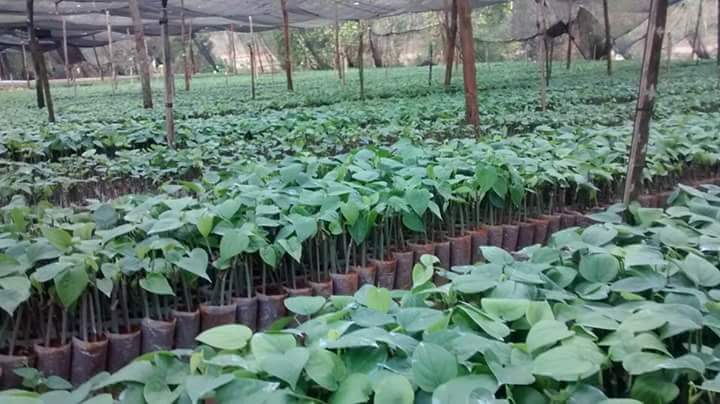 Runner shoots from high yielding and healthy vines are kept coiled on wooden pegs fixed at the base of the vine to prevent the shoots from coming in contact with soil and striking roots.
Runner shoots from high yielding and healthy vines are kept coiled on wooden pegs fixed at the base of the vine to prevent the shoots from coming in contact with soil and striking roots.
The runner shoots are separated from the vine during February-March, and after trimming the leaves, cuttings of 2-3 nodes are planted either in nursery beds or in polythene bags filled with potting mixture (soil, sand and farm yard manure in 2:1:1 ratio).
Adequate shade has to be provided and the polythene bags are to be irrigated frequently. The cuttings become ready for planting during May-June
2. Serpentine method
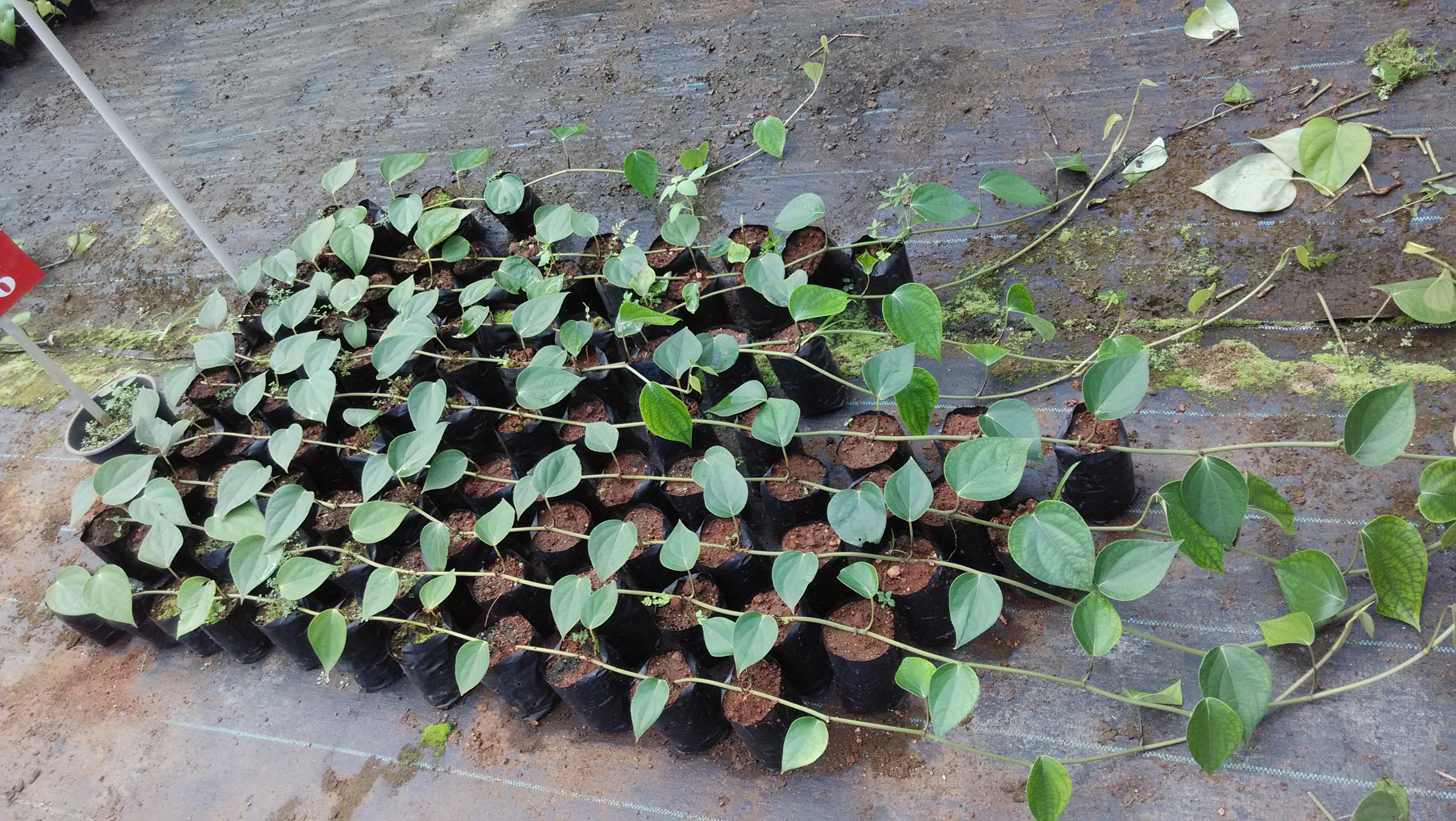
The method requires grown up rooted cuttings in 20 x 10 cm poly bags. Rooted cuttings are arranged in one end of the nursery and each cutting is trained to grow horizontally. As shoot grows, bags filled with the nursery mixture are kept underneath each node and allowed to strike roots. It is essential to ensure that each node touches the mixture.The shoot is then allowed to grow for about 3 months that can produce about 10-15 single noded rooted cuttings. This process continues in such a way that a single node gets rooted in each bag until the shoot reaches the last bag in a row. 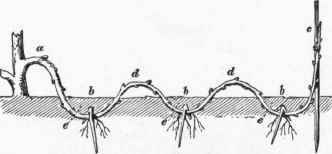 Once 20 nodes get rooted, the first 10 polythene bags with rooted nodes should be separated by cutting the internodes and the cut ends are also pressed into the bag. The axillary bud from each node in the bag sprouts and develops into 4-5 noded rooted cuttings in about 2-3 months. After a gap of another 20-30 days, the rest of the bags also can be separated. About 40-60 rooted cuttings can be produced from a single plant during a year.
Once 20 nodes get rooted, the first 10 polythene bags with rooted nodes should be separated by cutting the internodes and the cut ends are also pressed into the bag. The axillary bud from each node in the bag sprouts and develops into 4-5 noded rooted cuttings in about 2-3 months. After a gap of another 20-30 days, the rest of the bags also can be separated. About 40-60 rooted cuttings can be produced from a single plant during a year.
3. Pepper shoot multiplication or Rapid multiplication method (Bamboo method)
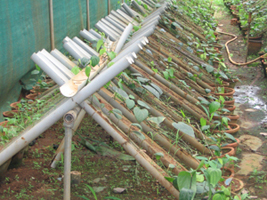
A propagation technique developed in Sri Lanka has been modified for adoption in India for quick and easy multiplication of black pepper vines. In this method, a trench of 45 cm depth, 30 cm width and of convenient length is made. The trench is filled with rooting medium comprising of forest soil, sand and farm yard manure in 1:1:1 ratio. Split halves of bamboo or split halves of PVC pipes are fixed at 45° angle by keeping split portion facing upward on a strong support on one side of the trench. Rooted cuttings are planted in the trench at the rate of one cutting for each bamboo split. The lower portions of the bamboo splits are filled with rooting medium (preferably weathered coir dust-farm yard manure mixture in 1:1 ratio) and the growing vine is tied to the bamboo split in such a way to keep the nodes pressed to the rooting medium. Each single nodded cutting with the bunch of roots intact is cut and planted in polythene bags filled with fumigated potting mixture. Trichoderma @ 1g and VAM @ 100 cc/kg of soil can be added to the potting mixture.
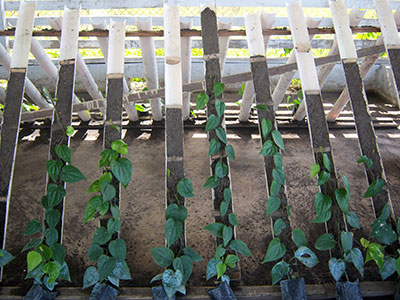
The buds start developing in about three weeks and the poly bags can then be removed and kept in shade till main field planting.
The advantages of this method of propagation are
(i) rapid multiplication rate (1:40)
(ii) well developed root system
(iii) higher field establishment
(iv) vigorous growth as a result of better root system
4.Orthotropic shoots.
Orthotropic shoots are erect growing leader shoots along the support/ standard (climbing shoots). Orthotropic shoots can be cut or extracted from the top up to 6 – 7 nodes down on the support. Too tender or too woody shoots need to be avoided. The medium matured green shoots are selected. These shoots with 5-6 node bits are planted directly in the planting pits. Two or three shoots per standards areused and their number varies from place to place. Orthotropic shoots as source of planting materials are obtained from 2-3 year old vines. Plants raised with these shoots generally flower early and fruiting laterals start right from the base of the vine.
5.Trench method

A simple, cheap and efficient technique for propagating black pepper from single nodes of runner shoots taken from field grown vines has been developed. A pit of 2.0 m × 1.0 m × 0.5 m size is dug under a cool and shaded area. Single nodes of 8 – 10 cm length and with their leaf intact are, taken from runner shoots of field grown vines. They are planted in polythene bags (25 cm × 15 cm, 200 gauge) filled with a mixture of sand, soil, coir dust and cow dung in equal proportions with their leaf axil exposed above the potting mixture. After keeping the bags in the pit, the pit should be covered with a polythene sheet. The cuttings should be irrigated at least five times a day with a rose can. Cuttings in poly bag are drenched 2 – 3 times with copper oxychloride (2 g/litre).
After about 1 month, new shoots start emerging from the leaf axil. The cuttings can be taken out of the pit after two months of planting and kept in a shaded place and watered twice a day. These cuttings will be ready for field planting after about 2 ½ months. By this method 80 – 85% success rate can be obtained.
6.Plug-tray nursery technique
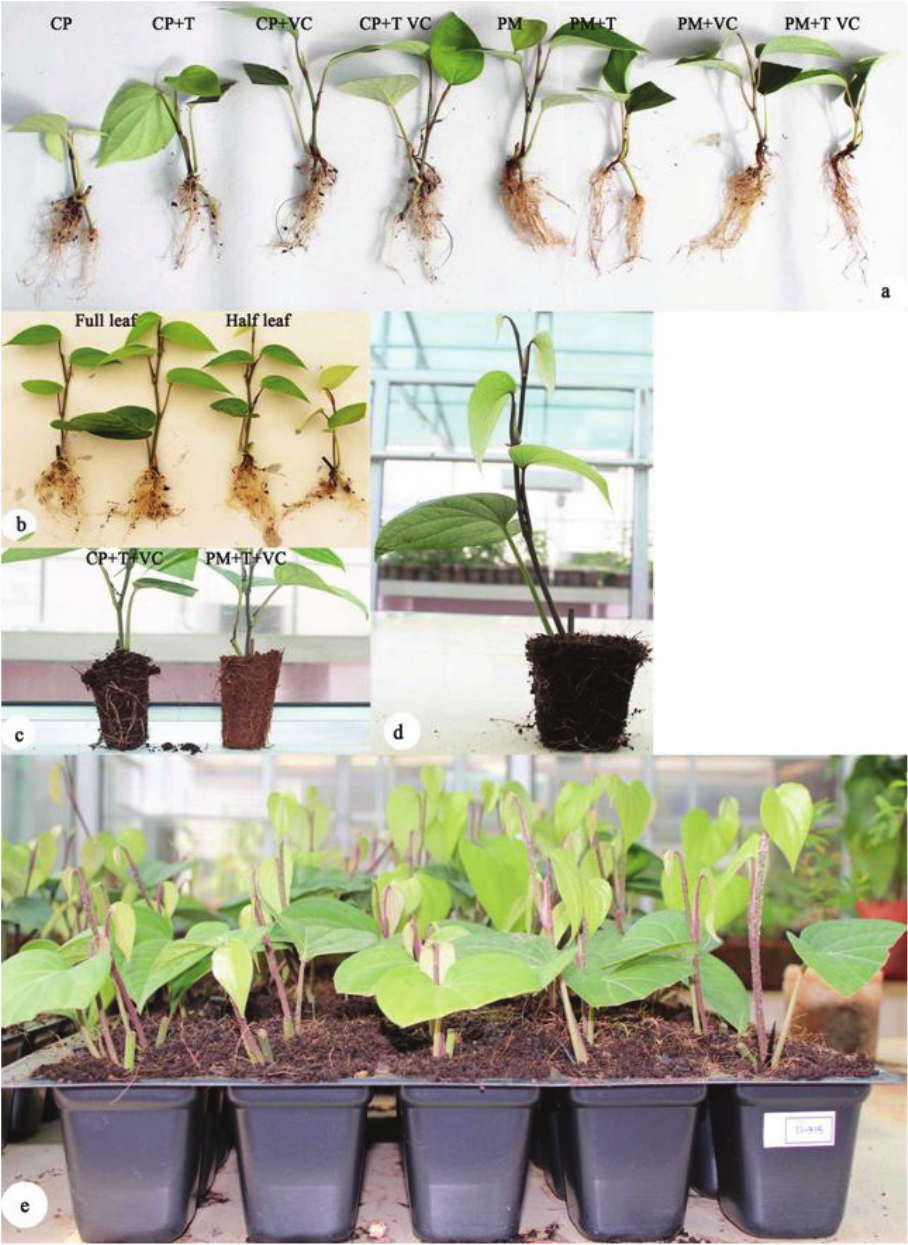
Partially composted coir pith and vermicompost (75:25) enriched with Trichoderma (in talc formulation, 10 7 cfu/g at the rate of 10 g/kg ) is an ideal potting medium for black pepper nursery for healthy planting material production using plug – trays compared to conventional multiplication.
The plug – tray nursery technique involves initial multiplication of black pepper runners in a modified serpentine method, ie. by allowing runners to strike roots in the partially decomposed coir pith and vermicompost (75:25) bed of convenient dimension (1.5 m width, 10 cm height and convenient length). The vines trail on rooting medium and strike roots at every node. After 45 – 60 days, leaving the terminal 5 nodes, about 15 – 20 node rooted runner is cut into single node rooted cuttings and transferred to plug – trays (cell dimension of 7.5 × 7.5 × 10.0 cm) filled with soil – less nursery mixture [composted coir pith and vermicompost (75:25) enriched with Trichoderma ]. Better rooting and establishment is recorded under humidity controlled green house (27±2 ° C) with intermittent mist. The cuttings are retained in the trays for about 45 – 60 days (4 – 5 leaf stage) for initial establishment. The established cuttings are then transferred to shade net/ naturally ventillated green house for hardening (45- 60 days). Healthy black pepper rooted cuttings are ready for field planting after 120 – 150 days.
7.Vertical column method
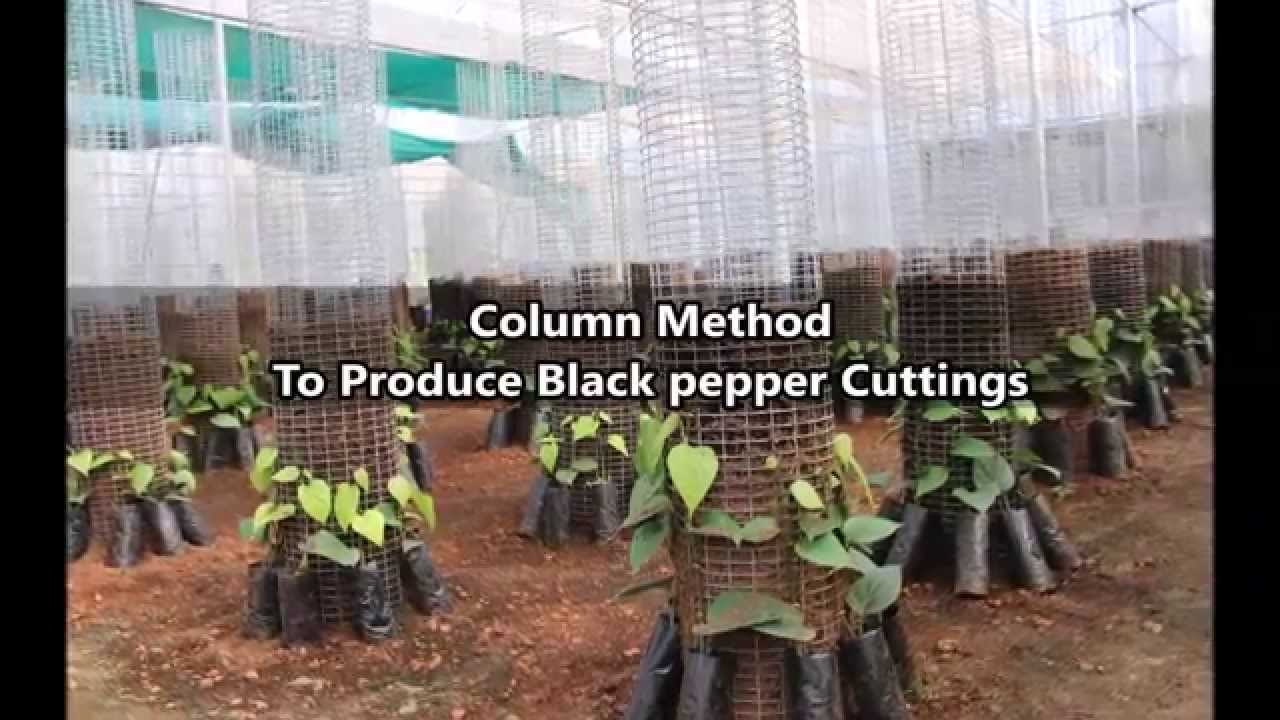
A novel method of intensifying quality planting material production has been standardized using vertical cloums with soil-less media. The technique involves growing orthotropes on vertical column (2 m height, 0.3 m diameter) made of half an inch plastic coated welded wire mesh. The column is filled with partially decomposed coirpith and vermicompost @ 3:1 ratio fortified with bio-control agent Trichoderma harzianum. Growing the vine on vertical column can be effectively utilized for the production of three types of planting material i.e., singlenode cuttings, top shoots with lateral branch (use of top shoots for field planting is having advantage of producing fruit bearing branch from the base and start yielding early) and laterals or plagiotropes which can be used for production of bush pepper.
The hi-tech poly house (temperature of 25-28°C and relative humidity 75-80% with intermittent misting) is advisable for the above productionsystem. Eight to ten cuttings can be planted around each vertical column. The cuttings are allowed to trail on the column ensuring that each node comes in contact with the medium. It takes about four to five months for the cuttings to reach the top of the column. At this stage each vine will have around 20 nodes with few lateral branches (at 12th-15th node). The top 5-7 nodes with lateral branches can be used as orthotropic shoots for field planting.In four to five months time, about 150 single node cuttings, 10 – 15 laterals and 10 top shoots can be produced in this method. Two hundred such columns can be accommodated in a poly house size of 320 m2. In a year, three harvesting cycles can be made. These cuttings can be rooted further for field planting using pro-trays.
Source :
- Directorate of Arecanut and Spices Development,Department of Agriculture and Cooperation Ministry of Agriculture, Government of India Calicut 673005, Kerala, India
- ICAR- Indian Institute of Spices Research,Kozhikode – 673 012, Kerala

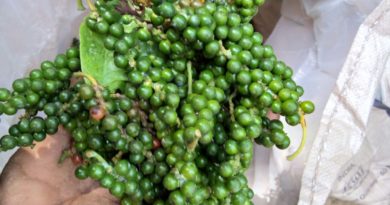
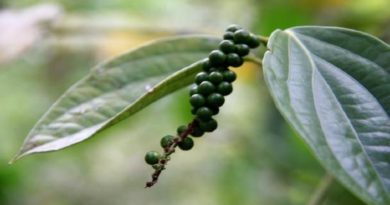
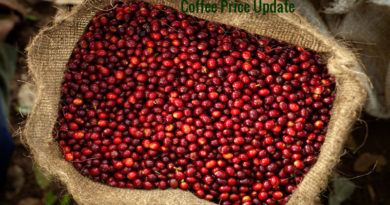
Nice information